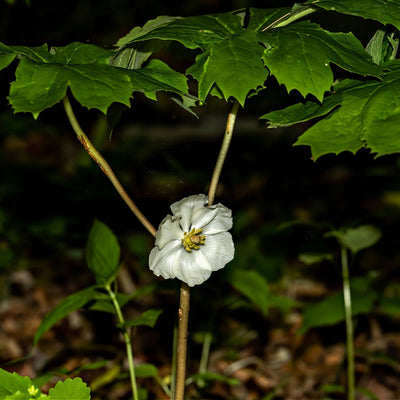May Apples are a Perennial Wood Favorite
May Apples are a Perennial Wood Favorite That Thrives in Naturalized Shade Gardens
May Apple — Podophyllum Peltatum — is native to most parts of North America east of the Continental Divide, with habitat stretching from New England and Southern Canada down to Texas. Like many woodland herbaceous perennials, May Apple grows in clumps on the forest floor and forms large, dense colonies when left to its own devices in the wild. Prized for its resistance to deer and rabbits, homeowners often use this plant in woodland gardens when replicating a natural environment. Because May Apple typically goes dormant in Summer after its bloom season, it isn't used in the perennial border. Still, it is valued as one of Spring's first signs of life, emerging in early spring and forming dense, bright green carpets before the deciduous trees above them even bud. May Apple offers its floral display in April and May, featuring large white or rose-colored blooms that grow in the axils of the large, umbrella-like leaves and are up to three inches across. Although they're often partially hidden by the foliage, the flowers present a beautiful picture as they glow under dappled sunlight. Bumblebees and other pollinating insects often buzz around May Apples while their fragrant flowers bloom.
May Apples Are Low-Maintenance Plants That Produce Beautiful Flowers and Edible Fruit
May Apples are easy to cultivate and require little, if any, extra work once they're established. A good choice for placing under trees and using as a transitional perennial on the edges of yards that give way to woodland environments, May Apple needs well-drained soil high in organic matter. Although this plant prefers shaded conditions, it can withstand a certain amount of drought without extra watering, making it an excellent candidate for those seeking to keep utility costs at a minimum. The flowers of May Apples are followed by lemon-shaped fruit that starts a fresh green color but ripens to gold with a purple or pinkish tinge. The fruit is edible and is often used to make preserves, but it's important to note that other parts of the plant are toxic to people and pets.
A favorite of organic gardening enthusiasts, May Apples don't require chemical fertilizer, pesticides, or insecticides. They generally thrive under localized soil conditions, mainly when planted under deciduous trees, because fallen leaf matter provides the type of soil enrichment that they need. Unlike the vast majority of perennials, they don't need to be cut back in Autumn because they enter dormancy at some point in summer, saving busy gardeners even more time. Their leaves should be left in place or worked into the soil to add to the organic matter this plant requires to put on its best performance. May Apples reproduce by underground rhizomes and generally don't need to be divided. Recommended for USDA hardiness zones 3-8.

